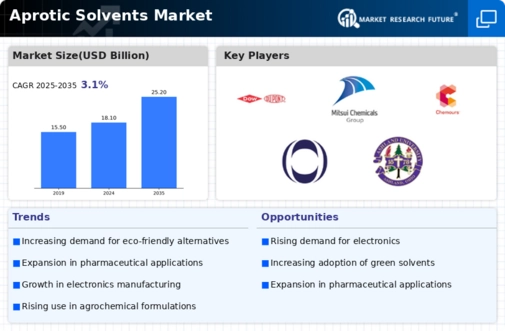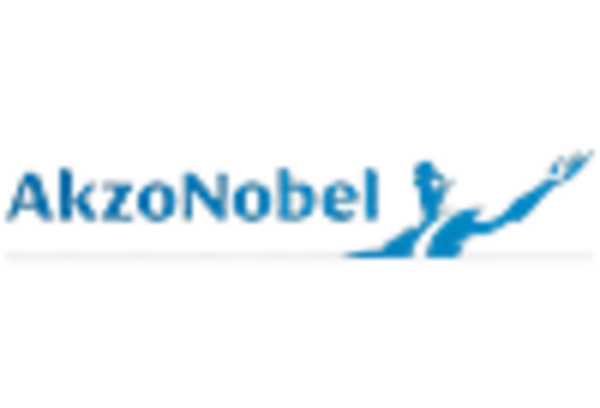-
Executive Summary
-
Market Introduction
-
Market Definition
-
Scope of the Study
-
List of Assumptions
-
Markets Structure
-
Market Research Methodology
-
Research Process
-
Primary Research
-
Secondary Research
-
Market Size Estimation
-
Forecast Model
-
Market Dynamics of Global Aprotic Solvents Market
-
Introduction
-
Drivers
-
Restraints
-
Opportunities
-
Challenges
-
Trends/Technology
-
Market Factor Analysis of Global
-
Aprotic Solvents Market
-
Supply Chain Analysis
- Raw Material Suppliers
- Manufacturers/Producers
- Distributors/Retailers/Wholesalers/E-Commerce
- End Users
-
Porter’s Five Forces Analysis
- Threat
- Bargaining Power of Buyers
- Bargaining Power
- Threat of Substitutes
- Intensity of Competitive
-
of New Entrants
-
of Suppliers
-
Rivalry
-
Global Aprotic Solvents Market, by Source
-
Introduction
-
Bio-Based
- Market Estimates & Forecast, 2023-2032
-
Market Estimates & Forecast, by Region, 2023-2032
-
Synthetic
- Market Estimates & Forecast,
-
Market Estimates & Forecast, 2023-2032
-
by Region, 2023-2032
-
Global Aprotic Solvents Market, by Type
-
Introduction
-
N-methyl-2-pyrrolidone, benzene
- Market Estimates & Forecast,
- Market Estimates & Forecast, by Region, 2023-2032
- Market Estimates & Forecast, 2023-2032
- Market
-
Toluene
-
Estimates & Forecast, by Region, 2023-2032
-
Acetone
- Market
- Market Estimates & Forecast,
-
Estimates & Forecast, 2023-2032
-
by Region, 2023-2032
-
Chloroform
- Market Estimates & Forecast,
- Market Estimates & Forecast, by Region, 2023-2032
- Market Estimates & Forecast, 2023-2032
- Market Estimates
-
Others
-
& Forecast, by Region, 2023-2032
-
Global Aprotic Solvents Market, by
-
End-Use Industry
-
Introduction
-
Chemical
- Market Estimates
- Market Estimates & Forecast, by Region,
-
& Forecast, 2023-2032
-
Healthcare
- Market Estimates & Forecast, 2023-2032
- Market Estimates & Forecast, by Region, 2023-2032
-
Oil &
- Market Estimates & Forecast, 2023-2032
- Market Estimates
-
Gas
-
& Forecast, by Region, 2023-2032
-
Electronics
- Market Estimates
- Market Estimates & Forecast, by Region,
-
& Forecast, 2023-2032
-
Paints & Coatings
- Market Estimates & Forecast,
- Market Estimates & Forecast, by Region, 2023-2032
-
Global Aprotic Solvents Market, by Region
-
Introduction
-
North America
- Market Estimates & Forecast, 2023-2032
- Market Estimates &
- Market Estimates & Forecast, by
- Market Estimates & Forecast, by End-Use Industry,
- US
- Canada
-
Forecast, by Material, 2023-2032
-
Application, 2023-2032
-
Estimates & Forecast, by Application, 2023-2032
-
& Forecast, by End-Use Industry, 2023-2032
-
Estimates & Forecast, 2023-2032
-
by Material, 2023-2032
-
Europe
- Market Estimates & Forecast, 2023-2032
- Market
- Market Estimates &
- Market Estimates & Forecast,
- Germany
- Italy
-
Estimates & Forecast, by Material, 2023-2032
-
Forecast, by Application, 2023-2032
-
by End-Use Industry, 2023-2032
-
& Forecast, 2023-2032
-
France
-
Estimates & Forecast, by Material, 2023-2032
-
Forecast, by Application, 2023-2032
-
by End-Use Industry, 2023-2032
-
Forecast, 2023-2032
-
Market Estimates & Forecast, by End-Use Industry, 2023-2032
-
& Forecast, by Material, 2023-2032
-
by Application, 2023-2032
-
Industry, 2023-2032
-
Spain
-
Market Estimates & Forecast, 2023-2032
-
Market Estimates
-
Market Estimates & Forecast,
-
Market Estimates & Forecast, by End-Use
-
UK
-
Market Estimates & Forecast,
-
Market Estimates & Forecast, by Material, 2023-2032
-
Market Estimates & Forecast, by Application, 2023-2032
-
Market Estimates & Forecast, by End-Use Industry, 2023-2032
-
& Forecast, by Material, 2023-2032
-
by Application, 2023-2032
-
Industry, 2023-2032
-
Russia
-
Market Estimates & Forecast, 2023-2032
-
Market Estimates
-
Market Estimates & Forecast,
-
Market Estimates & Forecast, by End-Use
-
Poland
-
Market Estimates & Forecast,
-
Market Estimates & Forecast, by Material, 2023-2032
-
Market Estimates & Forecast, by Application, 2023-2032
-
Market Estimates & Forecast, by End-Use Industry, 2023-2032
-
of Europe
-
Rest
-
Market Estimates & Forecast, 2023-2032
-
Market Estimates & Forecast, by Material, 2023-2032
-
& Forecast, by Application, 2023-2032
-
by End-Use Industry, 2023-2032
-
& Forecast, 2023-2032
-
China
-
Estimates & Forecast, by Material, 2023-2032
-
Forecast, by Application, 2023-2032
-
by End-Use Industry, 2023-2032
-
Forecast, 2023-2032
-
Market Estimates
-
Market Estimates & Forecast,
-
Asia-Pacific
- Market Estimates
- Market Estimates & Forecast, by Material,
- Market Estimates & Forecast, by Application, 2023-2032
- Market Estimates & Forecast, by End-Use Industry, 2023-2032
- India
-
Market Estimates & Forecast, by End-Use Industry, 2023-2032
-
& Forecast, by Material, 2023-2032
-
by Application, 2023-2032
-
Industry, 2023-2032
-
& Forecast, 2023-2032
-
Rest of Asia Pacific
-
Estimates & Forecast, by Application, 2023-2032
-
& Forecast, by End-Use Industry, 2023-2032
-
Forecast, by Material, 2023-2032
-
Application, 2023-2032
-
Estimates & Forecast, by Application, 2023-2032
-
& Forecast, by End-Use Industry, 2023-2032
-
Estimates & Forecast, 2023-2032
-
by Material, 2023-2032
-
Estimates & Forecast, by Application, 2023-2032
-
& Forecast, by End-Use Industry, 2023-2032
-
Estimates & Forecast, 2023-2032
-
by Material, 2023-2032
-
Japan
-
Market Estimates & Forecast, 2023-2032
-
Market Estimates
-
Market Estimates & Forecast,
-
Market Estimates & Forecast, by End-Use
-
Australia & New Zealand
-
Market Estimates
-
Market Estimates & Forecast, by Material,
-
Market Estimates & Forecast, by Application, 2023-2032
-
Market Estimates & Forecast, by End-Use Industry, 2023-2032
-
Market Estimates & Forecast, 2023-2032
-
Market Estimates & Forecast, by Material, 2023-2032
-
Market
-
Market Estimates
-
Middle East & Africa
- Market Estimates & Forecast, 2023-2032
- Market Estimates &
- Market Estimates & Forecast, by
- Market Estimates & Forecast, by End-Use Industry,
- GCC
- Israel
- North Africa
- Turkey
- Rest of Middle East & Africa
-
Market Estimates & Forecast, by End-Use Industry, 2023-2032
-
Latin America
- Market Estimates & Forecast, 2023-2032
- Market Estimates &
- Market Estimates & Forecast, by
- Market Estimates & Forecast, by End-Use Industry,
- Brazil
- Mexico
- Argentina
-
Forecast, by Material, 2023-2032
-
Application, 2023-2032
-
Estimates & Forecast, by Application, 2023-2032
-
& Forecast, by End-Use Industry, 2023-2032
-
Estimates & Forecast, 2023-2032
-
by Material, 2023-2032
-
Market Estimates & Forecast, by Material, 2023-2032
-
& Forecast, by Application, 2023-2032
-
by End-Use Industry, 2023-2032
-
Estimates & Forecast, 2023-2032
-
by Material, 2023-2032
-
Market Estimates
-
Market Estimates & Forecast,
-
Rest of Latin America
-
Market
-
Market Estimates & Forecast,
-
Market Estimates & Forecast, by Application,
-
Market Estimates & Forecast, by End-Use Industry, 2023-2032
-
Company Landscape
-
Introduction
-
Market Strategy
-
Key Development Analysis
-
(Expansion/Merger & Acquisition/Joint Venture/New
-
Product Development/Agreement/Investment)
-
Company Profiles
-
DowDuPont
- Company Overview
- Financial Updates
- Product/Business
- Strategy
- Key Developments
- SWOT
-
Segment Overview
-
Analysis
-
BASF SE
- Company Overview
- Financial Updates
- Product/Business Segment Overview
- Strategy
- Key
- SWOT Analysis
-
Developments
-
Mitsui Chemicals, Inc.
- Financial Updates
- Product/Business Segment
- Strategy
- Key Developments
- SWOT Analysis
-
Company Overview
-
Overview
-
The Chemours Company
- Company Overview
- Financial Updates
- Product/Business Segment Overview
- Strategy
- Key
- SWOT Analysis
-
Developments
-
INEOS
- Company Overview
- Financial Updates
- Product/Business Segment Overview
- Key Developments
- SWOT Analysis
-
Strategy
-
Eastman
- Company Overview
- Financial Updates
- Strategy
- Key Developments
- SWOT Analysis
-
Chemical Company
-
Product/Business Segment Overview
-
Royal Dutch Shell PLC
- Company Overview
- Financial Updates
- Product/Business Segment Overview
- Key Developments
- SWOT Analysis
-
Strategy
-
Celanese
- Company Overview
- Financial Updates
- Strategy
- Key Developments
- SWOT Analysis
-
Corporation
-
Product/Business Segment Overview
-
Mitsubishi Chemical Corporation
- Company
- Financial Updates
- Product/Business Segment Overview
- Strategy
- Key Developments
- SWOT Analysis
- Company Overview
- Financial Updates
- Strategy
- Key Developments
- SWOT Analysis
-
Overview
-
Ashland Inc
-
Product/Business Segment Overview
-
Asahi Kasei Corporation
- Company
- Financial Updates
- Product/Business Segment Overview
- Strategy
- Key Developments
- SWOT Analysis
-
Overview
-
Conclusion
-
LIST OF TABLES
-
Global Aprotic Solvents Market,
-
by Region, 2023-2032
-
North America: Aprotic Solvents Market, by Country,
-
Europe: Aprotic Solvents Market, by Country, 2023-2032
-
Asia-Pacific: Aprotic Solvents Market, by Country, 2023-2032
-
Table
-
Middle East & Africa: Aprotic Solvents Market, by Country, 2023-2032
-
Table
-
Latin America: Aprotic Solvents Market, by Country, 2023-2032
-
Global
-
Aprotic Solvents Material Market, by Regions, 2023-2032
-
North America:
-
Aprotic Solvents Material Market, by Country, 2023-2032
-
Europe: Aprotic
-
Solvents Material Market, by Country, 2023-2032
-
Table10 Asia-Pacific: Aprotic
-
Solvents Material Market, by Country, 2023-2032
-
Table11 Middle East & Africa:
-
Aprotic Solvents Material Market, by Country, 2023-2032
-
Table12 Latin America:
-
Aprotic Solvents Material Market, by Country, 2023-2032
-
Table13 Global Aprotic
-
Solvents Application Market, by Regions, 2023-2032
-
Table14 North America: Aprotic
-
Solvents by Application Market, by Country, 2023-2032
-
Table15 Europe: Aprotic
-
Solvents Application Market, by Country, 2023-2032
-
Table16 Asia-Pacific: Aprotic
-
Solvents Application Market, by Country, 2023-2032
-
Table17 Middle East &
-
Africa: Aprotic Solvents Application Market, by Country, 2023-2032
-
Table18
-
Latin America: Aprotic Solvents Application Market, by Country, 2023-2032
-
Table19
-
Global Aprotic Solvents End-Use Industry Market, by Regions, 2023-2032
-
Table20
-
North America: Aprotic Solvents End-Use Industry Market, by Country, 2023-2032
-
Table21 Europe: Aprotic Solvents End-Use Industry Market, by Country, 2023-2032
-
Table22 Asia-Pacific: Aprotic Solvents End-Use Industry Market, by Country, 2023-2032
-
Table23 Middle East & Africa: Aprotic Solvents End-Use Industry Market, by
-
Country, 2023-2032
-
Table24 Latin America: Aprotic Solvents End-Use Industry
-
Market, by Country, 2023-2032
-
Table25 Global Material Market, by Region, 2023-2032
-
Table26 Global Application Market, by Region, 2023-2032
-
Table27 Global End-Use
-
Industry Market, by Region, 2023-2032
-
Table28 North America: Aprotic Solvents
-
Market, by Country
-
Table29 North America: Aprotic Solvents Market, by Material
-
Table30 North America: Aprotic Solvents Market, by Application
-
Table31 North
-
America: Aprotic Solvents Market, by End-Use Industry
-
Table32 Europe: Aprotic
-
Solvents Market, by Country
-
Table33 Europe: Aprotic Solvents Market, by Material
-
Table34 Europe: Aprotic Solvents Market, by Application
-
Table35 Europe: Aprotic
-
Solvents Market, by End-Use Industry
-
Table36 Asia-Pacific: Aprotic Solvents
-
Market, by Country
-
Table37 Asia-Pacific: Aprotic Solvents Market, by Material
-
Table38 Asia-Pacific: Aprotic Solvents Market, by Application
-
Table39 Asia-Pacific:
-
Aprotic Solvents Market, by End-Use Industry
-
Table40 Middle East & Africa:
-
Aprotic Solvents Market, by Country
-
Table41 Middle East & Africa: Aprotic
-
Solvents Market, by Material
-
Table42 Middle East & Africa: Aprotic Solvents
-
Market, by Application
-
Table43 Middle East & Africa: Aprotic Solvents Market,
-
by End-Use Industry
-
Table44 Latin America: Aprotic Solvents Market, by Country
-
Table45 Latin America: Aprotic Solvents Market, by Material
-
Table46 Latin
-
America: Aprotic Solvents Market, by Application
-
Table47 Latin America: Aprotic
-
Solvents Market, by End-Use Industry
-
LIST OF FIGURES
-
Global
-
Aprotic Solvents Market Segmentation
-
Forecast Research Methodology
-
Five Forces Analysis of Global Aprotic Solvents Market
-
FIGURE 4
-
Value Chain of Global Aprotic Solvents Market
-
Share of Global Aprotic
-
Solvents Market in 2020, by Country (%)
-
Global Aprotic Solvents Market,
-
Global Aprotic Solvents Market Size, by Material, 2020
-
Share of Global Aprotic Solvents Market, by Material, 2023-2032
-
FIGURE
-
Global Aprotic Solvents Market Size, by Application, 2020
-
Share
-
of Global Aprotic Solvents Market, by Application, 2023-2032
-
Global
-
Aprotic Solvents Market Size, by End-Use Industry, 2020
-
Share of
-
Global Aprotic Solvents Market, by End-Use Industry, 2023-2032

















Leave a Comment